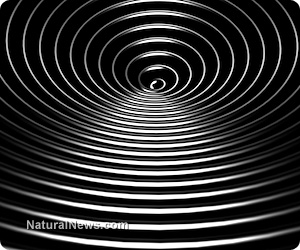
Studies reveal the effectiveness of medical hypnosis
Wednesday, April 03, 2013 by: Mike Bundrant
Tags: medical hypnosis, studies, effectiveness
- Newly released JFK files reveal Pentagon's role in creating Lyme disease and covid in the same lab
- Dr. Suzanne Humphries makes bombshell appearance on Joe Rogan podcast, exposing vaccine industry deception back to POLIOMYELITIS
- L.A.'s rebuilding nightmare: Only 4 permits issued after fire destroys 6,000 homes
- Discovery of vast underground city beneath Giza pyramids challenges human history
- Black cumin seed oil emerges as a powerful ally against breast cancer and chronic inflammation
- Catastrophic 7.7 earthquake devastates Myanmar and Thailand; death toll could reach 100,000
- AI breakthrough slashes celiac disease diagnosis time from months to minutes
- The hidden battle in your glass: How A1 and A2 milk could shape your health
- Sugar-free deception: Artificial sweeteners hijack hunger signals, fuel obesity epidemic, study warns
- Europe braces for WAR as EU urges citizens to STOCKPILE FOOD, in latest provocations with Russia
- Thomas Massie’s Dual Loyalty Disclosure Act aims to restore American sovereignty by cracking down on foreign influence in Congress
- Putin vows to 'finish off' Ukraine, accuses West of prolonging the war
- Aluminum pollution: A silent threat to human health
- Tesla owners under siege: Road rage, vandalism and political backlash fuel fear among drivers nationwide
- Kiss Your Genetic Privacy Good-Bye! 23andMe Gets Green Light to Sell Your Intimate Genetic Details to Anyone They Want
- Chaos in Amsterdam: Five injured in broad daylight knife attack near Dam Square
- "Feel G.O.O.D. Gut Health Program" on BrightU: Dr. Basima Williams introduces the Feel-Good Plate Method
- Trump's 25% auto tariffs: A bold move to strengthen U.S. manufacturing despite short-term challenges
- Newly released JFK files reveal Pentagon's role in creating Lyme disease and covid in the same lab
- Analysis: The coming economic collapse, a mass uprising and Trump's three secret weapons to halt the growing revolt
- Trump nominates VACCINE ZEALOT Susan Monarez to lead the CDC, sidelining RFK Jr.'s reform efforts
- Trump's greatest betrayal so far: Accelerating Middle East wars, silencing dissent, and serving Zionist masters
- Dr. Mike Yeadon releases 15-minute testimony - WATCH - about genocidal intent of COVID “vaccines”
- Festive flavors: The sweet history, nutritional profile and health benefits of pecan pie
- Elon Musk: Aliens could be here on Earth RIGHT NOW
- Big Pharma's $8 Billion bribery scheme exposed: how doctors are pushed to prescribe junk science, not heal
- 5 Simple steps to boost your brainpower: How to strengthen executive function in a distracted world
- Trump reverses course on Gaza plan, says “nobody is expelling Palestinians”
- A lack of integrity in Academia: Harvard professor found GUILTY of fraudulent research to promote CRT theory
- Reclaim your health: How midlife exercise reverses years of inactivity
- Survival 101: Effective EMF blocking techniques
- Florida takes a stand: DeSantis proposes permanent ban on mRNA vaccine mandates
- Sugarcane extract superior to cholesterol-lowering drugs?
- California's social media censorship law struck down: A victory for free speech or a threat to online safety?
- OpenAI whistleblower who dissented against how the company trained ChatGPT found dead
- EPA advisor admits the agency is funneling billions to climate groups ahead of Trump’s return to White House
- EPA advisor admits the agency is funneling billions to climate groups ahead of Trump’s return to White House
- Newly released JFK files reveal Pentagon's role in creating Lyme disease and covid in the same lab
- California's social media censorship law struck down: A victory for free speech or a threat to online safety?
- Dr. Mike Yeadon releases 15-minute testimony - WATCH - about genocidal intent of COVID “vaccines”
- The Health Ranger releases “Vaccine Zombie” song and music video, using AI-animated zombies for the music video
- The pandemic as a tool for INDOCTRINATION: Understanding “The Indoctrinated Brain” by Dr. Michael Nehls
- Florida takes a stand: DeSantis proposes permanent ban on mRNA vaccine mandates
- “Why we influenced the 2020 elections”: Facebook files reveal the coordinated effort to bury the Hunter Biden laptop story
- Mike Adams releases country western hit single: Goin’ Back in Time is Comin’ Home
- Mike Adams releases music poetry sensation: A Child of God
- Unpacking the Lies That We’ve Been Fed – new song and music video released by Mike Adams, the Health Ranger
- Michigan sheriff announces criminal investigation into 2020 election crimes, Dominion Voting Systems
- Migrants are taking advantage of recent hurricanes to scam residents and loot their homes
- House Intelligence Committee calls for the ARREST and PROSECUTION of Dr. Anthony Fauci
- RFK Jr. clears key hurdle: Sen. Susan Collins backs controversial HHS nominee, signaling a new era for health policy
- Rep. Nancy Mace introduces bill to ban biological males from female facilities on federal property
- Peter Rost exposes Big Pharma corruption in his book “The Whistleblower: Confessions of a Healthcare Hitman”
- Mike Adams releases new song and music video: Nothing More Disgusting Than a Globalist
- Red Cross issues warning to stop blood plasma donations from vaccinated people
- Scientists confirm: GENIUS brain function can be spontaneously unleashed in humans without any apparent cause
- EPA advisor admits the agency is funneling billions to climate groups ahead of Trump’s return to White House
- HYSSOP: What research reveals about the health benefits of this ancient holy herb
- Two containers with completed ballots fall out of truck in Florida
- Fully vaccinated about to see “tsunami” of illness and death, warns virologist
- Global leaders unite to clamp down on “misinformation” with UN-backed Cascais Declaration
- BREAKING: 2025 NDAA authorizes mandatory military draft of WOMEN across America… as Pentagon pursues global NUCLEAR war with both Russia and China at the same time
- Michael Yon warns of a ZIONIST TAKEOVER in Trump’s second administration
- BOMBSHELL: DNA testing kits are a SCAM to develop ethnic-specific bioweapons
- Ozempic and Wegovy weight loss drugs are injectable LIZARD VENOM PEPTIDES that may unleash a devastating wave of organ failure… side effects align with symptoms of SNAKE BITES
- Israeli soldiers accused of even more torture and abuse in the West Bank
- These 13 countries just signed an agreement to engineer a global FAMINE by destroying food supply
- NASA admits that climate change occurs because of changes in Earth’s solar orbit, and NOT because of SUVs and fossil fuels
- RFK Jr. clears key hurdle: Sen. Susan Collins backs controversial HHS nominee, signaling a new era for health policy
- Sermon 30: How Jesus reveals Caesar’s FAKE CURRENCY and FALSE AUTHORITY
- Coriander seeds: Ancient medicine backed by modern science
- Arizona officials claim Maricopa County needs 10-13 days to tabulate results of the election
The validity of therapeutic hypnosis as a complementary modality is becoming recognized, as studies prove brainwave activity changes with hypnotic depth. As we move from the high-energy beta wave state to the slower theta waves, we experience perceptual and physiological changes; for example our eyes flutter, breathing is more rhythmic, the body is relaxed and time is distorted.
Interestingly, children and animals tend to reside in the alpha/theta waves, thus are more intuitive and emotional. According to Crawford, a prominent researcher in the hypnotic field, different parts of the brain are activated during hypnosis - some increasing from 13%-28%. Preliminary results also suggest the reward pathway in the brain involving dopamine is stimulated. In fact, research using fMRI shows that hypnosis requires more mental effort, hence individuals are in a heightened state of awareness.
The power of hypnosis coupled with suggestion changes belief systems by reframing the meaning we place on experience. William Tiller, a former Professor Emeritus at Stanford University aptly states, "What we give meaning to we become."
Studies on the effects of hypnotherapy abound, for example, those tested positive for tuberculosis using the Mantoux test method were able to inhibit the test reaction following hypnotic suggestion. Interestingly, the use of cooling images for burn victims greatly increased speed of recovery. Hypnotic suggestions given pre and post surgery reduced the need for excessive anesthesia and medication.
This clearly shows that hypnosis has a neuropsychoimmunological effect on the individual; highlighting its versatility, encompassing far more than it's traditional uses for habit management, fears and weight loss. So what allows us to delve into this part of ourselves? Consciousness is defined as awareness. How many of us are completely aware of every waking moment?
Quantum physics suggests that we are the creator of our own realities; it is our expectations and intention that creates the space around us. Indeed, William Tiller has researched the effects of intention on experimental outcome. In one study he demonstrated it was possible to repeatedly alter the acidity or alkalinity of water using intention. If this is evident with water what does this mean for the human body? We are 70% water after all!
This finding should have you on the edge of your seat, for it tells us that we are more powerful than our beliefs suggest and we significantly impact our lives and those around us. We do not live in a vacuum rather we are entangled one mind with another on a quantum level. Moreover, our emotional minds and physical bodies are tightly intertwined, thus we are co-creators not victims. Society conditions us to believe ego is our true essence.
This conditioning builds our expectations and belief system based on illusion. Consciousness is the beauty of being human. It's what gives the matter of which we are made the innate intelligence to create. Furthermore, consciousness is found in the animal, plant and microbial kingdom albeit at differing levels.
So if our cells have consciousness what information can we tap into using hypnosis? Consciousness is the energetic thread of our existence. Hypnosis therefore is the gateway to finding our authentic selves.
Sources for this article include:
http://dancesoulhypnotherapy.com
Baghdadi, G., Motie, A. N. (2009). An Investigation of Changes in Brain Wave Energy during Hypnosis with Respect to Normal EEG. Sleep and Hypnosis, 11: 40-45.
Bennet, H. L., Benson, D. R. & Hilgard, E. R. (1970). Preoperative instructions for decreased bleeding during spine sugery. Anesthesiol., 65: A245 (abstract).
Black, S. (1963b). Inhibition of immediate-type hypersensitivity response by direct suggestion under hypnosis. British Medical Journal, 6: 925-929.
Brigham and Women's Hospital (2012, February 29). Skin infection sheds light on immune cells living in our skin. ScienceDaily. Retrieved December 18, 2012, from http://www.sciencedaily.com/releases/2012/02/120229142136.htm
Crawford, H. J., Gur, R. C., Skolnic, B., Gur, R. E. & Benson, D. (1993). Effects of hypnosis on regional cerebral blood flow during ischemic pain with and without suggested hypnotic analgesia. International Journal of Psychophysiology, 15: 181-195.
Crawford, H. J. (1994). Brain Dynamics and Hypnosis: Attentional and disattentional Processes. International Journal of Clinical and Experimental Hypnosis, 42: 204-232.
Das, J.P. (1958). The Pavlovian Theory of Hypnosis: An Evaluation. The British Journal of Psychiatry, 104: 82-90.
Gruzelier, J. H. (1999). Hypnosis from a neurobiological perspective: A review of evidence and applications to improve immune function. Anales de Psicologia, 15: 111-132.
About the author:
Watch the free video The AHA! Process: An End to Self-Sabotage and discover the lost keys to personal transformation and emotional well-being that have been suppressed by mainstream mental health for decades.
The information in this video has been called the missing link in mental health and personal development. In a world full of shallow, quick-fix techniques, second rate psychology and pharmaceutical takeovers, real solutions have become nearly impossible to find. Click here to watch the presentation that will turn your world upside down.
Mike Bundrant is co-founder of the iNLP Center and host of Mental Health Exposed, a Natural News Radio program.
Follow Mike on Facebook for daily personal development tips.
Medical hypnosis at FETCH.news
Get independent news alerts on natural cures, food lab tests, cannabis medicine, science, robotics, drones, privacy and more.
Take Action: Support Natural News by linking to this article from your website
Permalink to this article:
Embed article link: (copy HTML code below):
Reprinting this article:
Non-commercial use OK, cite NaturalNews.com with clickable link.
Follow Natural News on Facebook, Twitter, Google Plus, and Pinterest
Science News & Studies
Medicine News and Information
Food News & Studies
Health News & Studies
Herbs News & Information
Pollution News & Studies
Cancer News & Studies
Climate News & Studies
Survival News & Information
Gear News & Information
News covering technology, stocks, hackers, and more



"Big Tech and mainstream media are constantly trying to silence the independent voices that dare to bring you the truth about toxic food ingredients, dangerous medications and the failed, fraudulent science of the profit-driven medical establishment.
Email is one of the best ways to make sure you stay informed, without the censorship of the tech giants (Google, Apple, Facebook, Twitter, YouTube, etc.). Stay informed and you'll even likely learn information that may help save your own life."
–The Health Ranger, Mike Adams













































